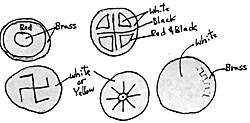Southern Italy is wall to wall Roman ruins. For military history/wargarner tourists there is almost too much to digest. Trajans Column, the Dying Gaul, countless statues and rdiefs of legions and barbarians, walls, roads, everything. Well, everything except frescos of the legions. The painters of Pompeii and other cities were more interested in Gods and lovas than their veterans. Typical. Below are a few of places that might be of interest to SAGA readers.
ROME
Castel San Angelo: On May 6, 1527 a force of Imperial Landsknechts and Spaniards ovaran the walls of Rome. Benvenuto Cellini, arquebus sharpshooter, bombardier excellent, master swordsman and goldsmith to Popes and kings, shot and killed the Duke of Bourbon from the walls of Rome. Then after falling back into the Castel San Angelo, he and fellow artist, Raffaello da Montelup, nearly routed the invaders with their skilled use of bombards.
Some years later, Cellini would be the most famous-ever prisoner and escapee of the Castel. Or so he claims in his fantastic autobiography. Cellini was certainly the greatest braggart, hot-head and perhaps, homicidal maniac of the sixteenth century. The Castel remains pretty much unchanged from the time of his exploits and should be of intaest to the military hobbyist.
Originally built as Hadrian's tomb in 134 AD, it became the citadel and focal point in the fortification of Rome (Borgo) against the Goths. Charlemagne slept there and numerous popes used it as a refuge from angry Roman mobs. Though the earthworks remain as a park, the outer walls of the fortress were removed some time ago. The citadel, however, remains intact and largely unaltered. In fact the mile long Papal escape bridge linking the Vatican to the Castel still appears functional.
Prominently situated on the Tiber, nearly all of the Castel San Angelo is open to the public. It has a very interesting display of 16 century bombards and piles of stone shot. It's primary value, however, is as a well preserved citadel. It is reputed to have a very large collection of small arms which span several centuries. Unfortunately, the collection is kept well out of sight of tourists. It is one of many inexplicable Italian museum mysteries.
Vatican Museum: Great place but not much military history here. The Vatican's primary strength is its collection of Greek and Roman statues and artifacts. There are thousands of statues. You will have no trouble locating your favorite emperor, hero, villain or God. For military history I suggest fast forwarding to the "Map Room" and checking out the mural of the naval battle of Lepanto, 1571, by a contemporary. Venetians vs Turks. Can't attest to its accuracy, but it's very impressive. There may be some interesting stuff (Swiss mercenary outfits) in the Storia d' Vatican exhibit. It was closed when I was there.
PAESTUM
Paestum is an archeological site of a city founded by the Greeks about 600 BC and ruled by the Lucians (Oscars) until 273 BC when the Romans took over. It is about 50 miles south of Naples. It has three massive Greek temples which are simply the best preserved buildings of their kind anywhere.
The ruins cover an area the size of a respectable Roman town. Very significantly (if you plan to paint a Lucian army [WRG Bk 1, list 47 or DBM Bk 2, list 8 ]) Paestrum contains the only extant paintings of the period. And many of them depict combatants and their arms and armor. Duncan Head's Armies of the Macedonian and Punic Wars (pgs 163- 166) gives good treatment to the Lucians incorporating many significant findings from Paestum. What follows is intended to supplement his comments.
Tunic colors are predominantly red and white. Tunic patterns include vertical stripes and checkered (window pane). Many, many figures wear what appears to be white (some red) linen or leather cuirasses with pteruges. Many wear bronze greaves, breast plates and broad belts. Head's comments on battle flags, in reality being enemy stripped tunics and belts, is certainly accurate.
 The plain, red and white boxy chariots are no doubt ceremonial. Cavalry horses
include bay, chestnut, gray, black with white face and white. Many of the shields are
faced solid polished bronze (brass). Other shield patterns, in addition to Head's, are
depicted below as best I can. All of them are clearly shield patterns except the last one
which may be a decorative motif. Maybe some of our Brit friend have some more
information on this.
The plain, red and white boxy chariots are no doubt ceremonial. Cavalry horses
include bay, chestnut, gray, black with white face and white. Many of the shields are
faced solid polished bronze (brass). Other shield patterns, in addition to Head's, are
depicted below as best I can. All of them are clearly shield patterns except the last one
which may be a decorative motif. Maybe some of our Brit friend have some more
information on this.
Back to Saga #59 Table of Contents
Back to Saga List of Issues
Back to MagWeb Magazine List
© Copyright 1997 by Terry Gore
This article appears in MagWeb (Magazine Web) on the Internet World Wide Web. Other military history articles and gaming articles are available at http://www.magweb.com